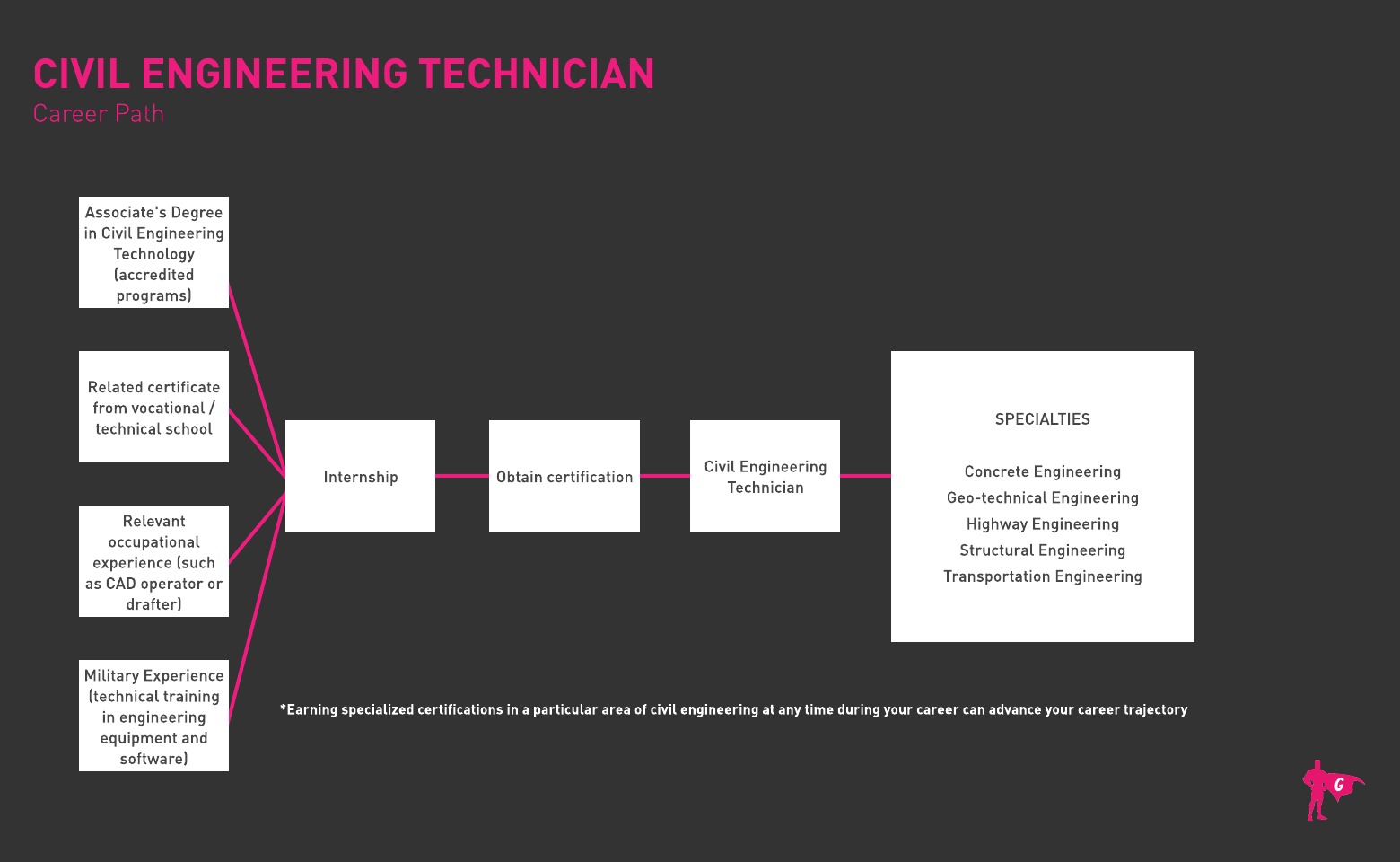Focos
Diseñador civil, Asistente de ingeniería civil, Diseñador de ingeniería civil, Técnico de diseño, Técnico de ingeniería, Asistente de ingeniería, Especialista en ingeniería y Técnico de ingeniería.
Los técnicos de ingeniería civil ayudan a los ingenieros civiles a planificar, diseñar y construir grandes proyectos de construcción como puentes, autopistas, servicios públicos y rascacielos. Sus responsabilidades incluyen una amplia gama de tareas, como la estimación de los costes de construcción, la elaboración de especificaciones de diseño, la preparación de planos y la topografía del terreno.
Muchos técnicos de ingeniería civil dicen que les gusta que su trabajo contribuya a hacer del mundo un lugar mejor o a mejorar la vida de alguien.
En un día normal:
- Visitar una obra para probar o recoger materiales e inspeccionar el progreso de un proyecto.
- Ayudar en las encuestas y realizar operaciones sobre el terreno.
- Revisar los documentos técnicos y estimar los costes operativos.
- Conducir a múltiples obras de construcción para garantizar que el trabajo se realiza correctamente y cumpliendo los plazos.
- Comunicarse con un equipo de profesionales que incluya ingenieros civiles, topógrafos, técnicos topógrafos y trabajadores de la construcción.
- Garantizar que la construcción se ajusta a las especificaciones del diseño y a los códigos aplicables.
- Revisar los planos del proyecto, preparar informes y documentar datos y actividades.
- Trabajar tanto en una oficina como en diversas obras.
Responsabilidades adicionales:
- Trabajar en laboratorios para analizar muestras de suelo y materiales de construcción.
- Establecer y supervisar los instrumentos para los estudios de tráfico.
- Estar familiarizado con diversos programas informáticos de diseño para analizar los datos del emplazamiento y redactar informes.
Dado que el trabajo en las obras se realiza en el exterior, el mal tiempo puede trastocar un día normal y afectar al horario laboral de los profesionales de este campo.
Habilidades sociales
- Pensamiento crítico
- Escucha activa
- Comprensión lectora, expresión escrita y expresión oral
- Matemáticas y resolución de problemas complejos
- Supervisión, juicio y toma de decisiones
Competencias técnicas
- Software analítico o científico - Software COGO de geometría de coordenadas
- Software CAD de diseño asistido por ordenador - Auto desk AutoCAD, Autodesk AutoCAD Civil 3D, Bently Microstation
- Software de entorno de desarrollo - Microsoft Visual Basic, National Instruments LabVIEW
- Microsoft Outlook, Office, Excel, Word
- Software ERP de planificación de recursos empresariales - SAP
- Software gráfico o de imagen fotográfica - Software gráfico
- Software de creación de mapas - Bentley Systems InRoads Suite, Software de modelado digital del terreno, Software ESRI ArcGIS, Software SIG de sistemas de información geográfica
- Empresas de construcción
- Empresas de servicios públicos
- Empresas de transporte
- Empresas de ingeniería y arquitectura
- Las Fuerzas Armadas de EE.UU.
- Gobiernos estatales y locales
Los técnicos de ingeniería civil pueden optar por especializarse en sectores específicos y tener títulos como:
- Técnico en ingeniería del hormigón
- Técnico en ingeniería geotécnica
- Técnico en ingeniería de carreteras
- Técnico en ingeniería estructural
- Técnico en ingeniería del transporte
Avanzar como técnico de ingeniería civil puede requerir formación adicional o certificación para adquirir conocimientos en campos especializados. Este compromiso de tiempo puede interferir con otras obligaciones personales o familiares, pero adquirir estos conocimientos, sobre todo en un nicho de gran demanda, puede merecer la pena.
- Diseño sostenible y proyectos de energías renovables
- Construcción modular y viviendas impresas en 3D
- Realidad aumentada y realidad virtual en el proceso de diseño
- Modelización de la información para la construcción (BIM)
- Materiales de construcción avanzados
- Edificios inteligentes
- Hogares conectados
- Robótica
Las personas que encuentran satisfactoria esta trayectoria profesional suelen disfrutar de actividades prácticas cuando eran más jóvenes y "aprendían haciendo". Les gusta estar al aire libre y trabajar con herramientas, maquinaria, madera, etc. También les gusta trabajar con datos y detalles y aprecian la rutina y el procedimiento.
- Los técnicos de ingeniería civil necesitan un título de grado medio en tecnología de ingeniería civil o algo muy similar. En algunos casos, basta con un título de formación profesional para empezar.
- Las titulaciones deben estar acreditadas por ABET
- La formación práctica adquirida a través de la experiencia laboral es vital. Muchos técnicos trabajan como delineantes u operadores de diseño asistido por ordenador.
- Según O*Net, el 30% de los trabajadores de este sector posee un certificado de estudios superiores, el 28% tiene estudios universitarios pero no un título, y el 21% tiene un título de asociado.
- Hay muchos programas informáticos con los que familiarizarse, entre ellos:
- Software analítico - Software de geometría de coordenadas COGO
- Software CAD - Autodesk AutoCAD, Autodesk AutoCAD Civil 3D o Autodesk Revit
- Software de entorno de desarrollo - Microsoft Visual Basic y National Instruments LabVIEW
- Las opciones de certificación incluyen:
- American Concrete Institute International - Instalador de anclajes adhesivos
- Instituto Nacional de Certificación en Tecnologías de la Ingeniería -
- Inspección de construcción de carreteras o Tecnologías de ingeniería
- Certificación en Pruebas de Potencia Eléctrica - Nivel III
- Autodesk, Inc. - Profesional certificado de Autodesk en Civil 3D para diseño de infraestructuras
- Asociación de Tecnología, Gestión e Ingeniería Aplicada - Certified Senior Technology
- Asociación para la Protección y el Rendimiento de los Materiales - Técnico en corrosión
- American Concrete Institute International - Técnico de ensayos de resistencia del hormigón
- Los trabajadores suelen recibir una amplia formación en el puesto de trabajo, así como
- Decide si quieres obtener un título de asociado o una certificación inicial para empezar
- Abastecerse de cursos de ingeniería, diseño, química, física, geometría y trigonometría.
- Aprender a utilizar el dibujo asistido por ordenador y los programas informáticos relacionados
- Acepta trabajos de nivel inicial como delineante u operador de CAD para adquirir experiencia en el mundo real.
- Colabora como voluntario en proyectos de construcción locales de Habitat for Humanity para aprender sobre materiales, métodos y herramientas. Echa un vistazo a las oportunidades en el extranjero, ¡si quieres más aventura!
- Obtenga experiencia laboral práctica adicional a través de las prácticas de Técnico en Ingeniería Civil
- Leer artículos y ver tutoriales sobre las funciones de los técnicos de ingeniería civil
- Pregunta a los técnicos de ingeniería civil en activo si te permiten ser su sombra o si pueden orientarte.
- Únase a organizaciones profesionales de ingeniería civil para aprender, crecer y establecer contactos.
- Cuando estés preparado, obtén la certificación del Instituto Nacional de Certificación en Tecnologías de Ingeniería u otras entidades aplicables. Las certificaciones no son obligatorias para todos los trabajos, pero pueden reforzar tus credenciales.

- Según las previsiones del BLS, las oportunidades laborales para los técnicos de ingeniería civil serán bastante constantes. La competencia será constante, por lo que para destacar se necesitarán certificaciones especiales o experiencia.
- Con unas 6.500 vacantes al año, es posible que los candidatos tengan que trasladarse allí donde haya trabajo. Los estados con mayores niveles de empleo para técnicos de ingeniería civil son Texas, California, Florida, Illinois y Carolina del Norte.
- Las prácticas de Técnico en Ingeniería Civil son una excelente manera de adquirir la tan necesaria experiencia práctica.
- Inscríbete para recibir alertas en portales de empleo como Indeed, Simply Hired, Glassdoor y Zippia, pero ten en cuenta también Craigslist para ofertas locales más pequeñas.
- Acude al centro de orientación profesional de tu centro de estudios para que te ayuden a preparar tu currículum y a practicar simulacros de entrevistas.
- Revise las plantillas de currículos de técnicos en ingeniería civil para obtener ideas sobre redacción y formatos
- Asiste a ferias de empleo locales para hablar con los reclutadores y compartir tu currículum.
- Habla con tus profesores y antiguos supervisores para que te den referencias personales.
- Estudia las preguntas de las entrevistas a técnicos de ingeniería civil para prepararte para las entrevistas.
Páginas web
- Consejo de Acreditación de Ingeniería y Tecnología (ABET)
- Instituto Americano de la Construcción en Acero
- Sociedad Americana de Técnicos Certificados en Ingeniería
- Sociedad Americana de Ingenieros Civiles
- Instituto Nacional de Certificación en Tecnologías de la Ingeniería
Libros
Hay varias ocupaciones que utilizan muchas de las mismas competencias que un técnico en ingeniería civil.
- Delineantes (arquitectura, obra civil, mecánica, electricidad y electrónica)
- Topógrafos
- Técnicos en topografía y cartografía
- Inspectores de construcción y edificación
- Ingenieros civiles
El trabajo de los técnicos de ingeniería civil puede verse por todas partes: en autopistas, puentes, rascacielos, aeródromos, presas, túneles y casi cualquier otra estructura esencial para la vida moderna. Quienes triunfan en esta profesión tienen una inclinación natural a resolver problemas, disfrutan con el trabajo práctico y se comunican con éxito con una gran variedad de personas. Este campo en expansión ofrece multitud de entornos de trabajo diferentes, lo que lo convierte en un campo interesante y gratificante para aquellos a los que les gustan los nuevos retos.
Noticias

Ofertas de empleo

Cursos y herramientas en línea

Expectativas salariales anuales
New workers start around $47K. Median pay is $60K per year. Highly experienced workers can earn around $76K.






